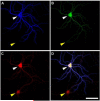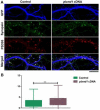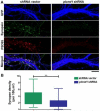Positive regulation of neocortical synapse formation by the Plexin-D1 receptor
- PMID: 25976775
- PMCID: PMC4465032
- DOI: 10.1016/j.brainres.2015.05.005
Positive regulation of neocortical synapse formation by the Plexin-D1 receptor
Abstract
Synapse formation is a critical process during neural development and is coordinated by multiple signals. Several lines of evidence implicate the Plexin-D1 receptor in synaptogenesis. Studies have shown that Plexin-D1 signaling is involved in synaptic specificity and synapse formation in spinal cord and striatum. Expression of Plexin-D1 and its principal neural ligand, Sema3E, by neocortical neurons is temporally and spatially regulated, reaching the highest level at the time of synaptogenesis in mice. In this study, we examined the function of Plexin-D1 in synapse formation by primary neocortical neurons in vitro. A novel, automated image analysis method was developed to quantitate synapse formation under baseline conditions and with manipulation of Plexin-D1 levels. shRNA and overexpression manipulations caused opposite changes, with reduction resulting in less synapse formation, an effect distinct from that reported in the striatum. The data indicate that Plexin-D1 operates in a cell context-specific fashion, mediating different synaptogenic outcomes depending upon neuron type.
Keywords: Image analysis; In vitro; Intracortical; Mouse; Synaptogenesis.
Copyright © 2015 Elsevier B.V. All rights reserved.
Figures






Similar articles
-
Semaphorin 3E-Plexin-D1 signaling controls pathway-specific synapse formation in the striatum.Nat Neurosci. 2011 Dec 18;15(2):215-23. doi: 10.1038/nn.3003. Nat Neurosci. 2011. PMID: 22179111 Free PMC article.
-
Distinct roles of neuroligin-1 and SynCAM1 in synapse formation and function in primary hippocampal neuronal cultures.Neuroscience. 2012 Jul 26;215:1-16. doi: 10.1016/j.neuroscience.2012.04.047. Epub 2012 Apr 25. Neuroscience. 2012. PMID: 22542674 Free PMC article.
-
Semaphorin 3E-Plexin-D1 signaling regulates VEGF function in developmental angiogenesis via a feedback mechanism.Genes Dev. 2011 Jul 1;25(13):1399-411. doi: 10.1101/gad.2042011. Genes Dev. 2011. PMID: 21724832 Free PMC article.
-
Divergent roles of Plexin D1 in cancer.Biochim Biophys Acta Rev Cancer. 2019 Aug;1872(1):103-110. doi: 10.1016/j.bbcan.2019.05.004. Epub 2019 May 30. Biochim Biophys Acta Rev Cancer. 2019. PMID: 31152824 Free PMC article. Review.
-
Glowing green pyramids: a false positive for neocortical neurogenesis reveals a novel neuronal-microglial fusion in the postnatal brain.J Neurosci. 2007 Feb 14;27(7):1507-8. doi: 10.1523/jneurosci.5475-06.2007. J Neurosci. 2007. PMID: 17304702 Free PMC article. Review. No abstract available.
Cited by
-
BCL11A Haploinsufficiency Causes an Intellectual Disability Syndrome and Dysregulates Transcription.Am J Hum Genet. 2016 Aug 4;99(2):253-74. doi: 10.1016/j.ajhg.2016.05.030. Epub 2016 Jul 21. Am J Hum Genet. 2016. PMID: 27453576 Free PMC article.
-
Cortical RORβ is required for layer 4 transcriptional identity and barrel integrity.Elife. 2020 Aug 27;9:e52370. doi: 10.7554/eLife.52370. Elife. 2020. PMID: 32851975 Free PMC article.
-
The Etiology of Moebius Syndrome-Making the Case for Animal Models.Int J Mol Sci. 2025 Apr 29;26(9):4217. doi: 10.3390/ijms26094217. Int J Mol Sci. 2025. PMID: 40362454 Free PMC article. Review.
-
Exome sequencing in families with severe mental illness identifies novel and rare variants in genes implicated in Mendelian neuropsychiatric syndromes.Psychiatry Clin Neurosci. 2019 Jan;73(1):11-19. doi: 10.1111/pcn.12788. Epub 2018 Dec 12. Psychiatry Clin Neurosci. 2019. PMID: 30367527 Free PMC article.
-
New functions of Semaphorin 3E and its receptor PlexinD1 during developing and adult hippocampal formation.Sci Rep. 2018 Jan 22;8(1):1381. doi: 10.1038/s41598-018-19794-0. Sci Rep. 2018. PMID: 29358640 Free PMC article.
References
-
- Akins MR, Biederer T. Cell–cell interactions in synaptogenesis. Curr. Opin. Neurobiol. 2006;16:83–89. - PubMed
-
- Arber S. Motor circuits in action: specification, connectivity, and function. Neuron. 2012;74:975–989. - PubMed
-
- Bellon A, et al. VEGFR2 (KDR/Flk1) signaling mediates axon growth in response to semaphorin 3E in the developing brain. Neuron. 2010;66:205–219. - PubMed
Publication types
MeSH terms
Substances
Grants and funding
LinkOut - more resources
Full Text Sources
Other Literature Sources
Molecular Biology Databases

